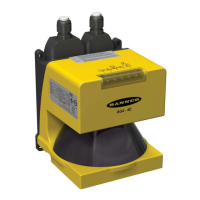Banner AG4 Series Safety Laser Scanner
Maximum Protective Field range: AG4-4E = 4 m (13.2'); AG4-6E = 6.25 m (20.6')
Start/Restart Interlock selectable (Manual or Auto reset)
Default = Automatic Start and Restart enabled (Auto)
Start/Restart (Reset) Interlock
The default configuration is automatic start and restart (automatic reset) with a 2 second delay after the Protective Field
becomes clear. The 2 second OSSD ON-delay is required by BS/DIN EN1525 and is meant to allow an individual to fully
clear the area protected by the Scanner.
In the AGV application option, the user has the choice of ―Automatic start,‖ ―Start Interlock‖ (manual reset at power-up),
or ―Start test.‖ This option affects all Field Pairs and is not dependent on Field Pair switchover parameters. (See Section
1.12.1 and 1.12.4 for complete information.)
Scanner Response Time
The ―AGV – Automated Guided Vehicle‖ application option automatically sets the Scanner response time to the 160 ms
default. The user may enter values from 80 ms to 640 ms, in 40 ms increments.
Vehicle Speed
The vehicle's expected maximum speed should be identified in the configuration. This allows the AG4 algorithm to
maximize the interference (dust) immunity. The options are up to 1500 mm/s, up to 2500 mm/s, up to 4000 mm/s, and
over 4000 mm/s (default).
Field Pair Switchover
In applications that incorporate Field Pair switchover, Minimum Distance D and Side Distance Z must be calculated
individually for all Protective Field pairs.
3.4.3 Protective Field Area – Length and Width
The horizontal Protective Field will prevent a collision only if the edge of the field in the direction of movement is
sufficiently distant from the vehicle and its load. This dimension (length) of the Protective Field is described as the
Minimum Distance D. The Side Distance Z (or the width of the Protective Field) is used to ensure that the sides of the
vehicle or a protruding load do not create a hazard.
It is highly recommended that an oversized Warning Field (in comparison to the Protective Field) be used. The
Warning Field and its associated output signal the approach of the mobile vehicle (e.g., by sounding a horn or
illuminating lights/beacons), and reduce the speed of the mobile vehicle. This can reduce the need or the amount of
braking and wear on the drive mechanisms.
The Protective Field configuration must take into account trapping/crushing hazards that could be created by physical
objects near the path of the mobile vehicle. An example would be an elevated conveyor that the sensing field of the Side
Distance Z passes under, but does not provide enough clearance. This situation can occur if the distance between the
end of the conveyor and the side of the mobile vehicle is less than 500 mm (20") per ISO 13854 (EN349) ―Minimum
Gaps to Avoid Crushing.‖
The following items apply to the calculation for determining the Minimum Distance D (Protective Field length):
Maximum speed of the AGV (Do not rely on the speed reduction initiated by the Warning Field!)
The Scanner response time
The response time of the mobile vehicle drive logic, including the response time of any interfacing devices,
such as UM-FA-..A safety module (25 ms)
The braking distance of the AGV (including environmental conditions, such as wet or slippery flooring)
Absence or lack of clearance in front or to the sides of the AGV
The speed of movement of an individual
The reduced efficiency of the braking system, due to wear
WARNING . . . AG4 RESPONSE TIME ADJUSTMENTS
Do not increase the Scanner’s 80 ms response time for vertically positioned Protective Fields such as work cell access (Entry/ Exit) or perimeter
guarding applications where a person could move quickly through the Protective Field without being detected.
Failure to follow this recommendation could result in serious bodily injury or death.
Buy: www.ValinOnline.com | Phone 844-385-3099 | Email: CustomerService@valin.com

